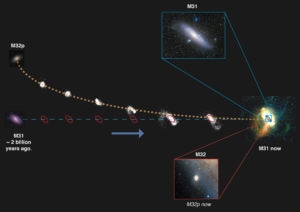Jul 27 2018
Researchers at the University of Michigan have inferred that the Andromeda galaxy, Earth’s nearest large galactic neighbor, shredded and cannibalized a huge galaxy two billion years ago.
 In this image, the Andromeda galaxy shreds the large galaxy M32p, which eventually resulted in M32 and a giant halo of stars. (Image credit: Richard D’Souza. Image of M31 courtesy of Wei-Hao Wang. Image of stellar halo of M31 courtesy of AAS/IOP.)
In this image, the Andromeda galaxy shreds the large galaxy M32p, which eventually resulted in M32 and a giant halo of stars. (Image credit: Richard D’Souza. Image of M31 courtesy of Wei-Hao Wang. Image of stellar halo of M31 courtesy of AAS/IOP.)
Even though it was mostly shredded, this huge galaxy left behind a rich track of evidence: a nearly invisible halo of stars larger than the Andromeda galaxy itself, a mysterious stream of stars, and a separate enigmatic compact galaxy, M32. Discovering and exploring this annihilated galaxy will help astronomers fathom how disk galaxies like the Milky Way progress and survive large mergers.
This disrupted galaxy, known as M32p, was the third-largest member of the Local Group of galaxies, following the Milky Way and Andromeda galaxies. Using computer models, Richard D’Souza and Eric Bell of the University of Michigan’s Department of Astronomy were able to put together this evidence, illuminating this long-lost sibling of the Milky Way. Their findings were reported in Nature Astronomy.
Researchers have long been aware that this virtually invisible large halo of stars surrounding galaxies contains the fragments of smaller cannibalized galaxies. A galaxy like Andromeda was estimated to have consumed numerous of its smaller companions. Scientists thought this would make it hard to learn about any one of them.
Using new computer simulations, the researchers were able to comprehend that even though many companion galaxies were cannibalized by Andromeda, most of the stars in the Andromeda’s outer faint halo were mostly contributed by ripping apart a single large galaxy.
“It was a ‘eureka’ moment. We realized we could use this information of Andromeda’s outer stellar halo to infer the properties of the largest of these shredded galaxies,” said lead author D’Souza, a postdoctoral researcher at U-M.
“Astronomers have been studying the Local Group - the Milky Way, Andromeda and their companions - for so long. It was shocking to realize that the Milky Way had a large sibling, and we never knew about it,” said co-author Bell, U-M professor of astronomy.
This galaxy, known as M32p, which was shredded by the Andromeda galaxy, was approximately 20 times larger than any galaxy which merged with the Milky Way over the course of its lifetime. M32p would have been colossal, making it the third largest galaxy in the Local Group after the Andromeda and the Milky Way galaxies.
This study might also provide answers to a long-standing mystery: the formation of Andromeda’s enigmatic M32 satellite galaxy, the researchers say. They propose that the compact and dense M32 is the remaining center of the Milky Way’s long-lost sibling, like the imperishable pit of a plum.
“M32 is a weirdo,” Bell said. “While it looks like a compact example of an old, elliptical galaxy, it actually has lots of young stars. It’s one of the most compact galaxies in the universe. There isn’t another galaxy like it.”
Their research may change the traditional understanding of how galaxies evolve, the scientists say. They grasped that the Andromeda’s disk endured an impact with an enormous galaxy, which would question the universal wisdom that such large interactions would terminate disks and form an elliptical galaxy.
The timing of the merger may also elucidate the thickening of the disk of the Andromeda galaxy as well as a burst of star formation two billion years ago, a finding which was autonomously reached by French scientists earlier this year.
The Andromeda Galaxy, with a spectacular burst of star formation, would have looked so different 2 billion years ago. When I was at graduate school, I was told that understanding how the Andromeda Galaxy and its satellite galaxy M32 formed would go a long way towards unraveling the mysteries of galaxy formation.
Eric Bell
The technique used in this research can be used for other galaxies, allowing measurement of their most enormous galaxy merger, the scientists say. With this knowledge, researchers can better unravel the complicated web of cause and effect that triggers galaxy growth and understand what mergers do to galaxies.